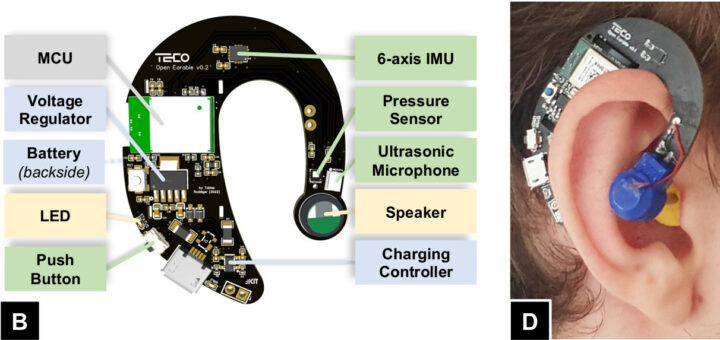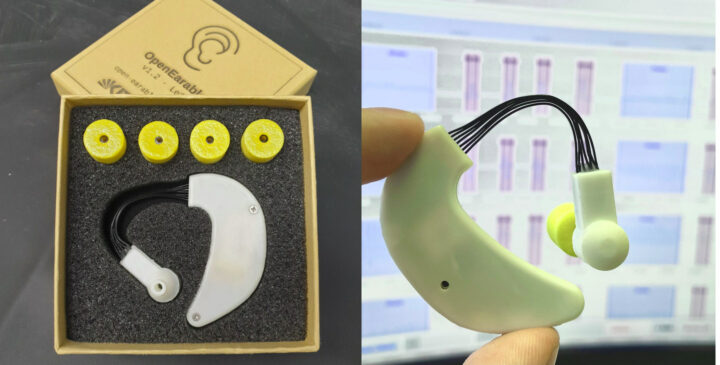OpenEarable is an open-source hardware earable, sometimes also called hearable, that fits around your ear and is based on the same u-blox NINA-B306 module found in the Arduino Nano 33 BLE Sense board.
Besides the Nordic Semi nRF52840 Arm Cortex-M4-based Bluetooth LE module, the design also features a speaker and ultrasonic microphone, a 6-axis IMU and a pressure sensor, as well as the circuitry for the battery, two LEDs, and a push button.

OpenEarable specifications:
- Wireless module – U-blox NINA-B306 module powered by a Nordic Semi nRF52840 Arm Cortex-M4F microcontroller @ 64MHz with 1MB Flash, 256KB RAM, Bluetooth 5.0 LE connectivity
- Audio – Built-in speaker and ultrasonic microphone (Knowles SPH0641LU4H-1)
- Sensors
- STMicro LPS22HBTR pressure and temperature sensor
- STMicro LSM6DSRTR 6-axis IMU with accelerometer and gyroscope
- USB – Micro USB port for power and programming
- Debugging – Solder pads for SWD interface
- Misc – Push button, charging LED, one programmable PWM LED
- Power Supply – Battery, voltage regulator, and charging controller

The OpenEarable firmware is implemented in C++ using the Arduino framework based on the implementation of the Arduino Nano 33 BLE Sense and can be found on GitHub, while the latest PCB layout and 3D files for the enclosure are available on the project’s page.
OpenEarable was designed as part of a research project by researchers from the Karlsruhe Institut of Technology and the University of Bath, where they demonstrated three applications of the platform: motion tracking to detect events such as standing still, walking, and jumping jacks using TinyML, ear canal pressure monitoring to detect jaw motion (e.g. chewing), and ear canal sound reflection to understand the shape of the ear canal which could potentially be used for authentication.
More recent versions of the Openearable design use two PCBs with wires between the mainboard and the microphone/speaker part as it must be more comfortable and adaptable to various ears than having a single PCB placed around your ear.
While the kit above looks like it may be ready for sale, it’s apparently not. You may try to contact the developers to get samples from the aforelinked project’s page, or manufacture it yourself. We’re told the design should cost around $40 per device for a batch of ten pieces.
Via Hackster.io

Jean-Luc started CNX Software in 2010 as a part-time endeavor, before quitting his job as a software engineering manager, and starting to write daily news, and reviews full time later in 2011.
Support CNX Software! Donate via cryptocurrencies, become a Patron on Patreon, or purchase goods on Amazon or Aliexpress






What’s the ultrasonic microphone for?
They are using an 18 KHz tone for “ear canal sound reflection”. I’m not sure this qualifies as “ultrasonic”, but they say this frequency is inaudible to the speaker.
Oh, that’s interesting. I’m guessing if you have sufficient hearing loss to need an aid, you may have very little sensitivity to 18KHz, so it’s ‘ultrasonic’ for them, I guess.
Nice there are open source alternatives but i don’t think anybody wants to walk around with such a huge thing on his ear, commercial ones are almost invisible
If I could hear well again for $40, I don’t care what it looks like.
I must admit I cringed when I saw the photo, too. Not because of the lack of elegance, but because of the raw PCB chafing against the ear. The newer version with the case and ear-bud on extender cables looks much more comfortable.
I’m still cringing from where they suggest you keep the battery, though. 🙂
I don’t think it’s a hearing aid
Thanks for sharing this. Interesting.
Is this dev kit available ti buy?
Sorry to ask.
Does the device track battery status, if so how does it do it?